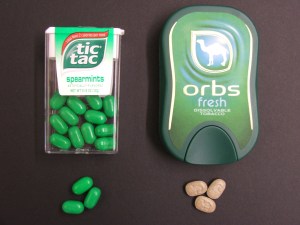
Image courtesy Harvard School of Public Health
Researchers at the Harvard School of Public Health, Centers for Disease Control and Prevention and Northern Ohio Poison Control Center argue that smokeless tobacco pellets manufactured by Camel look and taste so much like candy that their appeal to small children could put them at risk for poisoning. In a study released today by the journal Pediatrics, researchers analyzed more than 13,000 cases of tobacco ingestion among children under age 6 reported to poison control centers, finding that more than 70% of incidents were among children younger than 1 year. They also found that, after cigarettes, smokeless tobacco products were the second most commonly ingested form of tobacco. As part of the research, the study authors also analyzed the nicotine content in a new smokeless tobacco product—Camel Orbs pellets, which they say strongly resemble Tic Tac mints—being sold in three test markets in the U.S. They found that each pellet contained an average of .83 mg of nicotine. According to previous research, the minimum lethal dose of nicotine for children is 1.0 mg per kilogram (2.2lbs) of body weight, the authors say, yet lesser amounts of nicotine—as little as 1 mg—can “produce symptoms such as nausea and vomiting” in small children, and higher levels of nicotine exposure could lead to convulsions and impaired respiration.
In 2009 there was one case of ingestion by a 3-year-old reported to Oregon poison control, and two incidents involving small children consuming snus—smokeless tobacco sold in small pouches—according to the study. Yet, in addition to the potential risk of poisoning among small children, who may be enticed by the candy-like tobacco products that come in mint and cinnamon flavors, researchers also express concern about the appeal these types of products might have for adolescents. As they point out, the use of smokeless tobacco products has been slowly increasing among adolescents in recent years—rising 6% annually between 2002 to 2006.
With fewer people buying cigarettes—in part due to public anti-smoking campaigns and higher per pack taxes—and smoking bans making it more difficult to light up, tobacco companies have recently stepped up efforts to develop new, smokeless tobacco options for former smokers—or current smokers who cannot smoke in or around certain spaces. Yet representatives of R. J. Reynolds Tobacco, the company that produces Camel products, emphasize that these products are expressly for adults and deny any similarity between the Orbs products and candies such as Tic Tacs. As Reynolds spokesman David Howard told the New York Times, “Those packages don’t at all look alike to me.”
Authors of the new Pediatrics study disagree, and call for closer scrutiny of these products. They conclude: “[P]ublic health officials and poison control centers should be alert to reports of ingestion of novel products that claim to be tobacco products but more closely resemble candies or foods. In light of the novelty and potential harm of these dissolvable nicotine products, federal and other public health authorities are advised to study these products to determine the appropriate regulatory approach, on the basis of their potential to cause poisonings and to create addiction among youths.”

